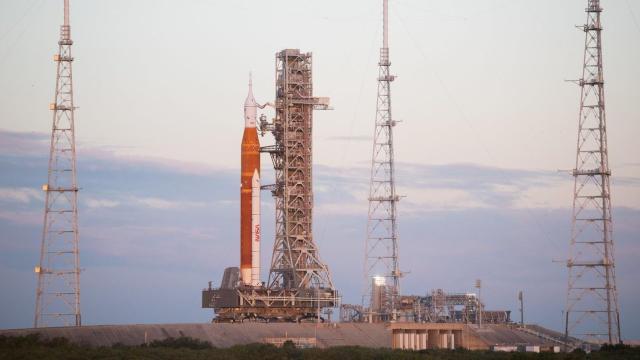The towering Space Launch System is back at Launch Pad 39B at NASA’s Kennedy Space Centre in Florida, following a nine-hour trek from the nearby Vehicle Assembly Building. The agency is targeting November 14 for the rocket’s first launch, an event that will kick off the Artemis 1 mission and NASA’s return to the Moon.
Could this be it? Might this finally be the last time NASA has to cart the 97.84 m-tall SLS rocket to the launch pad? I’m obsessively toggling between optimism and pessimism, as there’s good reason for both.
The launch attempt on November 14 will be NASA’s third try at getting the rocket off the ground, so it’s had plenty of practice at this point. But as we saw during those attempts and also during the wet dress rehearsals, SLS is a bit finicky, particularly when it comes to the loading of its liquid hydrogen propellant.
For this mission, an uncrewed Orion spacecraft will travel to the Moon and return to Earth three-and-a-half weeks later, without performing a lunar landing. The purpose of the Artemis 1 mission is to test the powerful new rocket and the Orion capsule, setting the stage for the crewed Artemis 2 mission in 2024.
NASA tried to launch SLS on August 29, but a faulty sensor forced a scrub. The second scrub on September 3 was the result of a hydrogen leak, prompting an impromptu cryogenic tanking test that the agency successfully performed on September 22. NASA was set to launch the rocket on September 27, but Hurricane Ian sent SLS back to the Vehicle Assembly Building for shelter.
Ground teams used the opportunity to recharge batteries associated with the rocket’s flight termination system, the booster, Orion, and batteries belonging to the secondary payload cubesats, Cliff Lanham, senior vehicle operations manager for NASA’s Exploration Ground Systems Program, told reporters Thursday at a press briefing. Some hardware was replaced and tests of the flight termination system were also done, he added, saying no outstanding issues remain open and that the rocket is ready to go.
A storm brewing in the Atlantic has captured the attention of Mark Berger, weather officer of the U.S. Space Force’s 45th Weather Squadron. The low pressure system, should it develop into something bigger, would likely affect Kennedy Space Centre at the middle of next week, he explained during the briefing. That said, Berger doesn’t expect the winds to pose a problem for SLS, and he’s not particularly concerned.
Should all go according to plan, the countdown for the third SLS launch attempt will begin just before 5:00 p.m. AEDT on November 12, and the rocket would blast off during a 69-minute launch window that opens at 4:07 p.m. AEDT on November 14. At the press briefing, Jim Free, associate administrator of NASA’s Exploration Systems Development Mission Directorate, said “everyone’s comfortable launching at night” and that he doesn’t see the darkness “as a barrier to getting the data that we need.”
That’s nice, but it’s a shame that the rocket won’t go up during daylight hours, or at least for this launch attempt. NASA has to consider a wide range of factors when determining launch windows, including the position of Earth, the Moon, and the Sun. Regardless, we won’t complain when we finally get to see SLS take flight — something that might actually happen in just 10 days.
More: NASA’s Artemis Moon Landing Program: Launches, Timeline, and More
